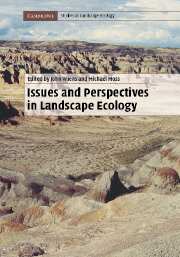Book contents
- Frontmatter
- Contents
- List of contributors
- Preface
- PART I Introductory perspectives
- PART II Theory, experiments, and models in landscape ecology
- PART III Landscape patterns
- PART IV Landscape dynamics on multiple scales
- PART V Applications of landscape ecology
- 18 Landscape ecology as the broker between information supply and management application
- 19 Farmlands for farming and nature
- 20 Landscape ecology and forest management
- 21 Landscape ecology and wildlife management
- 22 Restoration ecology and landscape ecology
- 23 Conservation planning at the landscape scale
- 24 Landscape conservation: a new paradigm for the conservation of biodiversity
- 25 The “why?” and the “so what?” of riverine landscapes
- PART VI Cultural perspectives and landscape planning
- PART VII Retrospect and prospect
- Index
- Plate section
- References
21 - Landscape ecology and wildlife management
from PART V - Applications of landscape ecology
Published online by Cambridge University Press: 20 November 2009
- Frontmatter
- Contents
- List of contributors
- Preface
- PART I Introductory perspectives
- PART II Theory, experiments, and models in landscape ecology
- PART III Landscape patterns
- PART IV Landscape dynamics on multiple scales
- PART V Applications of landscape ecology
- 18 Landscape ecology as the broker between information supply and management application
- 19 Farmlands for farming and nature
- 20 Landscape ecology and forest management
- 21 Landscape ecology and wildlife management
- 22 Restoration ecology and landscape ecology
- 23 Conservation planning at the landscape scale
- 24 Landscape conservation: a new paradigm for the conservation of biodiversity
- 25 The “why?” and the “so what?” of riverine landscapes
- PART VI Cultural perspectives and landscape planning
- PART VII Retrospect and prospect
- Index
- Plate section
- References
Summary
In his seminal book Game Management (1933: 128–129), Aldo Leopold set the stage for a marriage between landscape ecology and wildlife management:
The game must usually be able to reach each of the essential types each day. The maximum population of any given piece of land depends, therefore, not only on its environmental types or composition, but also on the interspersion of these types in relation to the cruising radius of the species. Composition and interspersion are thus the two principal determinants of potential abundance on game range … Management of game range is largely a matter of determining the environmental requirements and cruising radius of the possible species of game, and then manipulating the composition and interspersion of types on the land, so as to increase the density of its game population.
Although Leopold did not explicitly mention landscape ecology, he definitely introduced a landscape ecological perspective to wildlife management, at a time in history when ivory-billed woodpeckers (Campephilus principalis) still roamed swamp forests in Louisiana. Thirty years later radiotelemetry was made generally available, opening up a new era in wildlife biology. Now wildlife managers could see for themselves how the wildlife was moving around in the landscape. Some 70 years since Leopold's book, and 40 years since radiotelemetry was introduced, what is the state of the art? Have wildlife managers grasped the concepts of landscape ecology? Have landscape ecologists found wildlife management an interesting arena in which to play out their scientific endeavors?
- Type
- Chapter
- Information
- Issues and Perspectives in Landscape Ecology , pp. 208 - 216Publisher: Cambridge University PressPrint publication year: 2005
References
- 2
- Cited by

